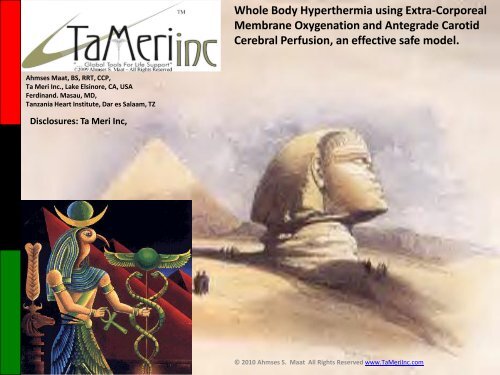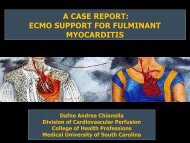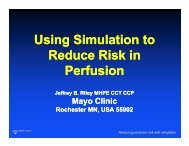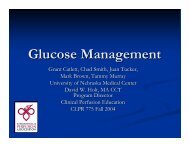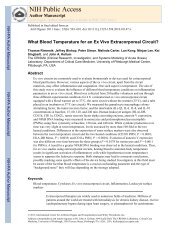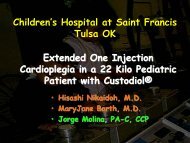Whole Body Hyperthermia using Extra-Corporeal ... - Perfusion.com
Whole Body Hyperthermia using Extra-Corporeal ... - Perfusion.com
Whole Body Hyperthermia using Extra-Corporeal ... - Perfusion.com
Create successful ePaper yourself
Turn your PDF publications into a flip-book with our unique Google optimized e-Paper software.
<strong>Whole</strong> <strong>Body</strong> <strong>Hyperthermia</strong> <strong>using</strong> <strong>Extra</strong>-<strong>Corporeal</strong><br />
Membrane Oxygenation and Antegrade Carotid<br />
Cerebral <strong>Perfusion</strong>, an effective safe model.<br />
Ahmses Maat, BS, RRT, CCP,<br />
Ta Meri Inc., Lake Elsinore, CA, USA<br />
Ferdinand. Masau, MD,<br />
Tanzania Heart Institute, Dar es Salaam, TZ<br />
Disclosures: Ta Meri Inc,<br />
© 2010 Ahmses S. Maat All Rights Reserved www.TaMeriInc.<strong>com</strong>
Medline/ Pub Med Search<br />
ASAIO J. 1996 Jul-Aug;42(4):250-4.<br />
Induction of whole body hyperthemia with venovenous perfusion.<br />
Vertrees RA, Tao W, Pencil SD, Sites JP, Althoff DP, Zwischenberger JB.<br />
Department of Surgery, University of Texas Medical Branch, Galveston 77554-0528, USA.<br />
<strong>Whole</strong> body hyperthermia can be used for the treatment of metastatic cancer and human immunodeficiency<br />
virus infections. The therapeutic effects of hyperthermia are dependent upon the actual temperature of the<br />
target tissues. Therefore, homogeneous distribution of heat and precise control of temperature gradients is<br />
critical. To describe heat distribution during hyperthermia induced by venovenous perfusion, the authors used<br />
multiple channel temperature monitoring and a servo-regulated perfusion/heat exchange system. Young swine<br />
were randomly assigned to either a heated group (perfusion-induced hyperthermia, target core temperature at<br />
43 degrees C, n = 6), or a control group (perfusion alone, target core temperature at 38 degrees C, n = 6). Blood<br />
was drained from the external jugular vein, heated with a <strong>com</strong>puter assisted heat exchange system, and<br />
reinfused through the femoral vein at a flow of 10 ml/kg-1/min-1. Temperature probes in the esophagus, right<br />
and left tympanic canals, brain, pulmonary artery, arterial and venous blood, rectus spinae muscle, kidney,<br />
rectum, bone marrow, bladder, subcutaneous tissue, gluteus, and skin were simultaneously recorded. During<br />
the heat induction phase, the maximum water temperature was 54 degrees C, with a heating gradient of the<br />
blood (blood in-blood out) at 6 degrees C. The maximum temperature difference between tissues was 3.6<br />
degrees C (kidney and esophagus) during heat induction, but decreased to 1.75 degrees C during maintenance.<br />
Bone marrow temperature was consistently 1-2 degrees C below the average core temperature of 43 degrees C<br />
throughout the experiment. The authors conclude that venovenous perfusion can predictably induce<br />
hyperthermia, but is associated with heterogenous temperature distribution among organs. Further studies are<br />
necessary to evaluate different perfusion and heating patterns to achieve homogenous hyperthermia.<br />
PMID: 8828779 [PubMed - indexed for MEDLINE]<br />
© 2010 Ahmses S. Maat All Rights Reserved www.TaMeriInc.<strong>com</strong>
Medline/ Pub Med Search<br />
ASAIO J. 1997 Sep-Oct;43(5):M830-8.<br />
<strong>Extra</strong>corporeal whole body hyperthermia treatments for HIV infection and AIDS.<br />
Ash SR, Steinhart CR, Curfman MF, Gingrich CH, Sapir DA, Ash EL, Fausset JM, Yatvin MB.<br />
HemoCleanse Inc., West Lafayette, Indiana 47906, USA.<br />
<strong>Whole</strong> body hyperthermia therapy (WBHT) is the elevation of the core body temperature to 42<br />
degrees C. In vitro studies have confirmed that 42 degrees C is cytocidal for virally infected<br />
lymphocytes, and even more effective when heating is repeated 4 days later. The safety and efficacy<br />
of two successive sessions of WBHT (4 days apart) was evaluated in 30 patients with AIDS (not on<br />
protease inhibitors), randomized to: 1) untreated controls, 2) low temperature WBHT for 1 hour at 40<br />
degrees C and repeated 96 hours later, and 3) high temperature WBHT for 1 hour at 42 degrees C<br />
and repeated 96 hours later. The sorbent suspension in the ThermoChem System (HemoCleanse,<br />
West Lafayette, IN) system automatically controlled blood phosphate, calcium, and other electrolyte<br />
concentrations during WBHT. In 1 year of follow-up after WBHT, there were positive effects of the<br />
therapy on frequency of AIDS defining events, Karnofsky score, and weight maintenance. However,<br />
effects on plasma HIV RNA and CD4 counts were transient. Two successive WBHT treatments were<br />
performed in four patients who were on protease inhibitor/triple drug therapy, but had suboptimal<br />
response. In follow-up for 6 months, plasma HIV RNA and CD4 improved after WBHT, and the patients<br />
remained clinically well. This WBHT may have specific advantages in patients with suboptimal<br />
response to protease inhibitor therapy.<br />
PMID: 9360163 [PubMed - indexed for MEDLINE]<br />
© 2010 Ahmses S. Maat All Rights Reserved www.TaMeriInc.<strong>com</strong>
Medline/ Pub Med Search<br />
ASAIO Journal: July/August 2002 - Volume 48 - Issue 4 - pp 350-354<br />
<strong>Perfusion</strong> Induced <strong>Hyperthermia</strong> for Oncologic Therapy<br />
with Cardiac and Cerebral Protection<br />
Hemmila, Mark R.; Foley, David S.; Casetti, Alfredo V.; Soldes, Oliver S.; Hirschl, Ronald B.; Bartlett, Robert H.<br />
Abstract<br />
Cancer can be preferentially damaged and killed at<br />
temperatures above 41.0° C. However, the heart and<br />
brain malfunction at this temperature, limiting the<br />
application of systemic hyperthermia in the treatment of<br />
metastatic cancer. We created a hyperthermic perfusion<br />
system that maximizes the temperature differential<br />
produced and extends the safe hyperthermic time.<br />
© 2010 Ahmses S. Maat All Rights Reserved www.TaMeriInc.<strong>com</strong>
Medline/ Pub Med Search<br />
ASAIO Journal: July/August 2002 - Volume 48 - Issue 4 - pp 350-354<br />
<strong>Perfusion</strong> Induced <strong>Hyperthermia</strong> for Oncologic Therapy with Cardiac and Cerebral<br />
Protection<br />
Hemmila, Mark R.; Foley, David S.; Casetti, Alfredo V.; Soldes, Oliver S.; Hirschl, Ronald B.; Bartlett, Robert H.<br />
Abstract<br />
• Venoarterial perfusion was instituted and the<br />
perfusate was warmed to 44 to 45°C. The dogs'<br />
rectal temperature was elevated to ≥ 42° C for 4<br />
hours. A small amount of venous blood was cooled<br />
to 28 to 30° C and reperfused into the right atrium<br />
to maintain the pulmonary artery temperature ≤<br />
38° C.<br />
© 2010 Ahmses S. Maat All Rights Reserved www.TaMeriInc.<strong>com</strong>
Medline/ Pub Med Search<br />
ASAIO Journal: July/August 2002 - Volume 48 - Issue 4 - pp 350-354<br />
<strong>Perfusion</strong> Induced <strong>Hyperthermia</strong> for Oncologic Therapy with Cardiac and Cerebral<br />
Protection<br />
Hemmila, Mark R.; Foley, David S.; Casetti, Alfredo V.; Soldes, Oliver S.; Hirschl, Ronald B.; Bartlett, Robert H.<br />
Abstract<br />
• Ten of 11 dogs survived the operative procedure,<br />
and no neurologic deficits were observed. The<br />
rectal temperature was successfully elevated to ≥<br />
42° C for 4 hours while maintaining the heart and<br />
brain at ≤ 38° C. Moderate serum biochemical<br />
changes were observed postprocedure.<br />
© 2010 Ahmses S. Maat All Rights Reserved www.TaMeriInc.<strong>com</strong>
Medline/ Pub Med Search<br />
ASAIO Journal: July/August 2002 - Volume 48 - Issue 4 - pp 350-354<br />
<strong>Perfusion</strong> Induced <strong>Hyperthermia</strong> for Oncologic Therapy with Cardiac and Cerebral<br />
Protection<br />
Hemmila, Mark R.; Foley, David S.; Casetti, Alfredo V.; Soldes, Oliver S.; Hirschl, Ronald B.; Bartlett, Robert H.<br />
Abstract<br />
• Lower abdominal and pelvic hyperthermia at 42° C<br />
can be safely produced and maintained for 4 hours<br />
<strong>using</strong> an extracorporeal perfusion circuit, while<br />
protecting the heart and brain from temperature<br />
elevation.<br />
© 2010 Ahmses S. Maat All Rights Reserved www.TaMeriInc.<strong>com</strong>
Medline/ Pub Med Search<br />
Immunol Res. 2010 Mar;46(1-3):137-54.<br />
Diverse immune mechanisms may contribute to the survival benefit seen in<br />
cancer patients receiving hyperthermia.<br />
Peer AJ, Grimm MJ, Zynda ER, Repasky EA.<br />
Department of Immunology, Roswell Park Cancer Institute, Buffalo, NY, 14263, USA.<br />
There is increasing documentation of significant survival benefits achieved in cancer patients<br />
treated with hyperthermia in <strong>com</strong>bination with radiation and/or chemotherapy. Most evidence<br />
collected regarding the mechanisms by which hyperthermia positively influences tumor control<br />
has centered on in vitro data showing the ability of heat shock temperatures (usually above 42<br />
degrees C) to result in radio- or chemosensitization. However, these high temperatures are<br />
difficult to achieve in vivo, and new thermometry data in patients reveal that much of the tumor<br />
and surrounding region is only heated to 40-41 degrees C or less as a result of vascular drainage<br />
from the target zone of the heated tumor. Thus, there is now a growing appreciation of a role for<br />
mild hyperthermia in the stimulation of various arms of the immune system in contributing to long<br />
term protection from tumor growth. Indeed, a review of recent literature suggests the existence<br />
of an array of thermally sensitive functions which may exist naturally to help the organism to<br />
establish a new "set point" of immune responsiveness during fever. This review summarizes recent<br />
literature identifying <strong>com</strong>plex effects of temperature on immune cells and potential cellular<br />
mechanisms by which increased temperature may enhance immune surveillance.<br />
PMID: 19756410 [PubMed - in process]<br />
© 2010 Ahmses S. Maat All Rights Reserved www.TaMeriInc.<strong>com</strong>
Hyperthermic Isolated Limb <strong>Perfusion</strong><br />
© 2010 Ahmses S. Maat All Rights Reserved www.TaMeriInc.<strong>com</strong>
Hyperthermic Intraperitoneal<br />
Chemotherapy (HIPEC)<br />
Cytoreduction<br />
(Debulking) Surgery<br />
© 2010 Ahmses S. Maat All Rights Reserved www.TaMeriInc.<strong>com</strong>
<strong>Whole</strong> <strong>Body</strong> <strong>Hyperthermia</strong> <strong>using</strong> <strong>Extra</strong>-<strong>Corporeal</strong> Membrane<br />
Oxygenation and Antegrade Carotid Cerebral <strong>Perfusion</strong>,<br />
an effective safe model.<br />
• Background: <strong>Whole</strong> <strong>Body</strong> <strong>Hyperthermia</strong> (WBH) Heat Shock (HS) level of<br />
44°C has a proven direct cytocidal effect on cancer and thermo-liable<br />
pathogens. With WBH, HS, critical Cerebral Hyperthermal Injury (CHI)<br />
may occur.<br />
• Purpose: To asses CHI prevention, cerebral hypothermia with<br />
simultaneous WBH, HS was performed. WBH gives a significant global<br />
therapeutic HS to all direct and adjoining tissues with vascular access.<br />
Target temperature for core body is T rectal @ 44°C, and cerebral is T-<br />
tympanic@ 35°C, respectively. To trial a rapid cerebral cooling the T<br />
tympanic@ 28°C was earmarked.<br />
© 2010 Ahmses S. Maat All Rights Reserved www.TaMeriInc.<strong>com</strong>
BIZ ≤ 30<br />
<strong>Whole</strong> <strong>Body</strong> <strong>Hyperthermia</strong> <strong>using</strong> <strong>Extra</strong>-<strong>Corporeal</strong> Membrane Oxygenation and Antergrade Carotid Cerebral <strong>Perfusion</strong>, an effective safe model.<br />
Tympanic Temp 35C<br />
Pulse Ox 96 ±2<br />
HYPERTHERMIC DIAGRAM<br />
*Confidential Ta Meri Inc*<br />
Art by:<br />
Ahmses Maat ,RRT, CCP, DMD<br />
Carotid<br />
Temp 44<br />
Foley<br />
Vent<br />
NG<br />
EKG 100<br />
±20<br />
MAP 80 ± 20<br />
I.V.<br />
Fem Art<br />
ABG<br />
Pump 2 Pump 1<br />
Fem Vein<br />
Sat %/ HCT<br />
Pedal<br />
Doppler<br />
Warming<br />
Blanket at 42C<br />
CVP<br />
15 ±3<br />
Art<br />
Line<br />
Heat<br />
Exchanger #2<br />
to 33C<br />
Oxygenator / Forane<br />
Heat Exchanger #1 to<br />
46C<br />
ABG, K, Na,<br />
Hct, Glucose<br />
ACT<br />
200s+<br />
© 2010 Ahmses S. Maat All Rights Reserved www.TaMeriInc.<strong>com</strong>
<strong>Whole</strong> <strong>Body</strong> <strong>Hyperthermia</strong> <strong>using</strong> <strong>Extra</strong>-<strong>Corporeal</strong> Membrane<br />
Oxygenation and Antegrade Carotid Cerebral <strong>Perfusion</strong>,<br />
an effective safe model.<br />
• Methods: Using the Aorta and Right Atria for vascular access on a 35kg<br />
goat, <strong>Extra</strong>-<strong>Corporeal</strong> Membrane Oxygenation (ECMO) was initiated.<br />
Using a cardioplegia delivery system, a proprietary cerebral protection<br />
solution was delivered.<br />
• Right antegrade carotid cerebral perfusion (ACCP) @ 300 ml/min ± 100<br />
ml/ min at 160 mmHg ± 30 mmHg was achieved and maintained. With<br />
systemic flows of 2.45 l/m ± 0.45 l/m, the mean BP was maintained at 80<br />
mmHg ± 20 mmHg. The HR was maintained at 100 ± 40 bpm. The digital<br />
Pulse Ox and Ear Ox was 96% ± 2%.<br />
• During systemic warming, the standard 1°C to 2°C gradient range was kept<br />
within the T-systemic water, arterial, venous, and rectal respectively. The<br />
pump time was 106 minutes. At 90 minutes, T –rectal @ 44°C and T-<br />
tympanic @ 35°C was achieved.<br />
• Then testing rapid cerebral hypothermia, T tympanic @ 28°C was achieved<br />
within 15 minutes while keeping T rectal@ 44°C.<br />
© 2010 Ahmses S. Maat All Rights Reserved www.TaMeriInc.<strong>com</strong>
<strong>Whole</strong> <strong>Body</strong> <strong>Hyperthermia</strong> <strong>using</strong> <strong>Extra</strong>-<strong>Corporeal</strong> Membrane<br />
Oxygenation and Antegrade Carotid Cerebral <strong>Perfusion</strong>,<br />
an effective safe model.<br />
• Summary: WBH with ECMO, HS therapy at T rectal 44°C, and ACCP,<br />
with cerebral hypothermia @ ≤ 35°C was achieved; thereby avoidance of<br />
CHI is implied.<br />
• Conclusion: While further study with additional indicators for validity is<br />
needed, this methodology, offers a potential solution to the threat of cancer<br />
metastasis and systemic thermo-liable pathogens that are sensitive to<br />
internal HS treatment while offering avoidance of CHI.<br />
© 2010 Ahmses S. Maat All Rights Reserved www.TaMeriInc.<strong>com</strong>
Tanzania Heart Institute<br />
Special Thanks for equipment donation to:<br />
Armando Rosales – Sales- Terumo Cardiovascular Medical<br />
Paul Johnson CP, Pomona Valley Hospital<br />
Bill Casey CCP and Monte McKrinstry CCP- Desert<br />
D`Salaam Regional hosts Hospital continental heart specialists seminar<br />
By The guardian reporter / www.ippmedia.<strong>com</strong><br />
7th November 2009<br />
Permanent Secretary in the Ministry of Health and Social Welfare Blandina Nyoni<br />
will today officiate at the sixth African Heart seminar to be held in Dar es Salaam.<br />
Briefing reporters in Dar es Salaam yesterday, Tanzania Heart Institute (TAHI)<br />
founder and president Dr. Ferdinand Masau said the four-day seminar would bring<br />
together more than 150 medical specialists from different countries across the<br />
world.<br />
www.TaMeriInc.<strong>com</strong><br />
HL-Machine, ECMO, VADs, ATS, Cancer<br />
<strong>Hyperthermia</strong><br />
© 2010 Ahmses S. Maat All Rights Reserved www.TaMeriInc.<strong>com</strong><br />
15
Thank<br />
You.<br />
© 2010 Ahmses S. Maat All Rights Reserved www.TaMeriInc.<strong>com</strong><br />
16


